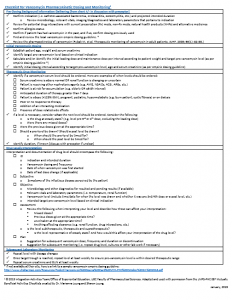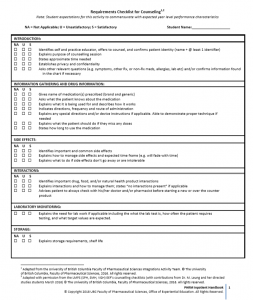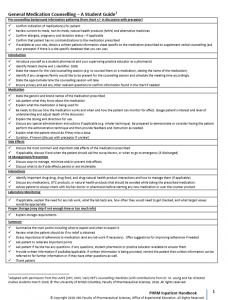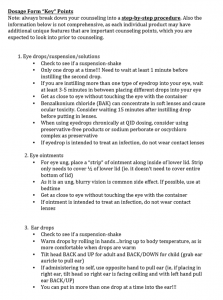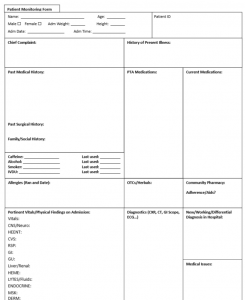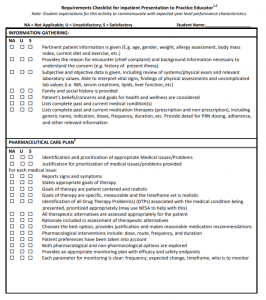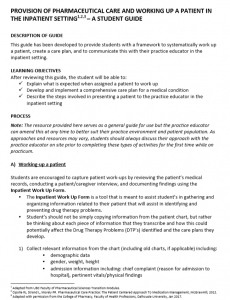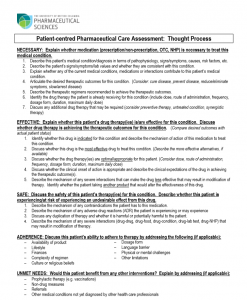What you will find here: UBC Integration Activities Team/OEE checklist outlining steps and considerations for initial vancomycin dosing, drug level interpretation, and monitoring.
Monthly Archives: February 2019
Counseling Requirements Checklist
What you will find here: UBC OEE checklist outlining components included in standard patient counseling process.
General Medication Counseling
What you will find here: UBC OEE guide outlining general components (e.g. Introduction, medication, side effects, interactions, etc.) to assess and include when counseling on medications.
Counseling Key Points for Dosage and Delivery Systems
What you will find here: Example document outlining key points to consider when counseling on various dosage forms.
Please note: Information on this document is not comprehensive as each individual product may include additional unique features that should be mentioned during patient counseling not listed here.
Example Dosage Form Key Points for Different Delivery Systems
Patient Work-up and Monitoring Form Example (Inpatient)
What you will find here: UBC OEE patient monitoring example template for patient assessment, DTP identification, and care plan development. The format and structure of this form is designed to capture a systematic approach to the pharmaceutical care thought process and presentation.
Checklist for Presenting to a Practice Educator (Inpatient)
What you will find here: UBC OEE Patient Work-up checklist that can be used to ensure that all relevant information regarding patient assessment and care plan is captured and presented to practice educator and other health care professionals.
Provision of Pharmaceutical Care and Working Up a Patient (Inpatient)
What you will find here: UBC OEE guide developed to provide a framework to systematically working up a patient, creating a care plan, and communicating this information to a practice educator in an inpatient setting.
NESA and Drug Therapy Problem Categories
What you will find here: Document outlining thought process for patient-centered pharmaceutical care (e.g., consideration for whether a medication is necessary, effective, safe, and patient adherence issues) and Drug Therapy Problem (DTP) categories.
European Society of Cardiology (ESC)/European Respiratory Society (ERS) Guidelines
What you will find here: Clinical practice guidelines on pulmonary hypertension, diagnosis and treatment.
- Go to https://www.escardio.org/Guidelines/Clinical-Practice-Guidelines/Pulmonary-Hypertension-Guidelines-on-Diagnosis-and-Treatment-of
- Click on the most up to date guideline available.
Pulmonary Hypertension (Guidelines on Diagnosis and Treatment of)
Infectious Diseases Society of America (IDSA)/American Thoracic Society (ATS) Guidelines
The Infectious Diseases Society of America (IDSA) is a community of over 11,000 physicians, scientists and public health experts who specialize in infectious diseases. Their purpose is to improve the health of individuals, communities, and society by promoting excellence in patient care, education, research, public health, and prevention relating to infectious diseases.
- Go to http://www.idsociety.org/Index.aspx
- Click on “Guidelines” and search “HAP” in Search box.
- Please note to access archived guidelines (older than 5 years old) please read the section under “IDSA Practice Guidelines” and follow the links.
IDSA Home
Asymptomatic bacteriuria (ASB) is a common finding in many populations, including healthy women and persons with underlying urologic abnormalities. The 2005 guideline from the Infectious Diseases Society of America recommended that ASB should be screened for and treated only in pregnant women or in an individual prior to undergoing invasive urologic procedures.

